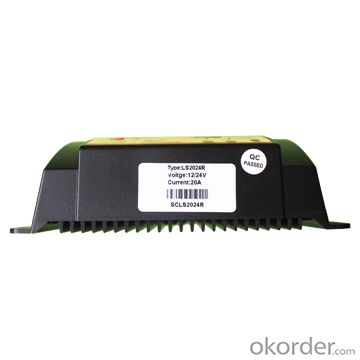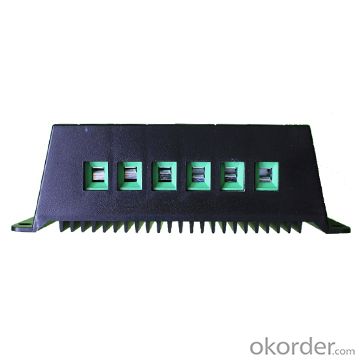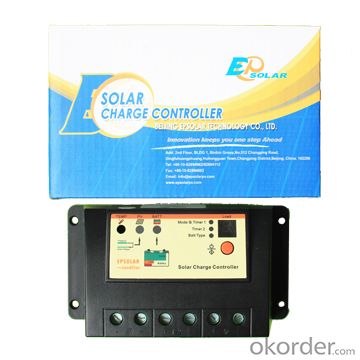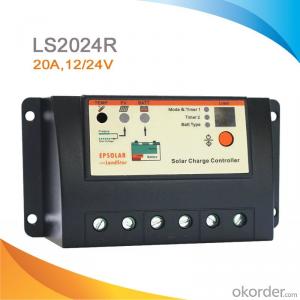PWM Solar Charge Controller,20A,12/24V with Integrated LED Driver
OKorder Service Pledge
OKorder Financial Service
You Might Also Like
Solar Controller Descriptions:
This series solar charge controller combines the solar charge controller and LED constant current driver Light and timer control (Single timer and dual timer optional) It It is ideal for public lighting area, such as street light, path way, garden lights, parking area, bus station etc.


Features:
·High efficient Series PWM charging
·Use MOSFET as electronic switch
·Widely used, automatically recognize day/night
·Digital LED menu with simple setting and easy using
·Intelligent timer function with 1-15 hours option
·Gel, Sealed and Flooded battery type option
·Temperature compensation

Electronic Protections:
·Overheating
·Over discharging
·Over charging
·Load overload
·Load short circuit
·PV reverse polarity
·Battery reverse polarity
Specification:
Electrical parameters | LS1024R | LS2024R |
Nominal System Voltage | 12 / 24VDC auto work | |
Rated Battery Current | 10A | 20A |
Max. Battery Voltage | 32V | |
Charge Circuit Voltage Drop | ≤0.26V | |
Discharge Circuit Voltage Drop | ≤0.15V | |
Self-consumption | ≤6mA | |
Overall dimension | 140 x 65 x 34mm | 144 x 75x 45mm |
Terminal | 4mm2 | 10mm2 |
Net weight | 0.15kg | 0.25kg |
Working temperature | -35℃ to +55℃ | |
Humidity | 10%-90% NC | |
Enclosure | IP30 | |
Battery Voltage Parameters (temperature at 25℃) | |||
Battery charging setting | Gel | Sealed | Flooded |
Equalize Charging Voltage | —— | 14.6V;x2/24V | 14.8V;x2/24V |
Boost Charging Voltage | 14.2V;x2/24V | 14.4V;x2/24V | 14.6V;x2/24V |
Float Charging Voltage | 13.8V;x2/24V | 13.8V;x2/24V | 13.8V;x2/24V |
Low Voltage Reconnect Voltage | 12.6V;x2/24V | 12.6V;x2/24V | 12.6V;x2/24V |
Low Voltage Disconnect Voltage | 11.1V;x2/24V | 11.1V;x2/24V | 11.1V;x2/24V |
Equalize Duration | —— | 2 hours | 2 hours |
Boost Duration | 2 hours | 2 hours | 2 hours |
- Q:How do I monitor the performance of a solar controller?
- To monitor the performance of a solar controller, you can follow these steps: 1. Check the display: Most solar controllers come with an LCD display that shows vital information such as battery voltage, current, charging status, and load status. Regularly checking this display will give you an idea of how your solar controller is performing. 2. Monitor battery voltage: Keep an eye on the battery voltage to ensure it remains within the optimal range. If it consistently falls below or exceeds the recommended levels, it could indicate a problem with the solar controller. 3. Evaluate charging and discharging rates: Observe how efficiently the solar controller charges the battery during the day and discharges it during the night. If you notice any significant discrepancies or irregularities, it may indicate a performance issue. 4. Use a data logging device: Some advanced solar controllers allow you to connect a data logging device that records and stores performance data. This data can be analyzed later to identify any patterns or anomalies in the controller's performance. 5. Regularly inspect connections and cables: Ensure all connections between the solar panels, battery, and controller are secure and free from any corrosion or damage. Faulty connections can affect the controller's performance. 6. Consult the user manual: Refer to the user manual provided by the manufacturer for specific instructions on monitoring and troubleshooting the solar controller. It may contain additional guidance or specific indicators to look for. By regularly monitoring these aspects, you can ensure your solar controller is operating optimally and take necessary action if any performance issues arise.
- Q:What is the voltage range for a solar controller?
- The voltage range for a solar controller typically varies between 12V to 48V, depending on the specific model and application.
- Q:How do you prevent battery over-temperature with a solar controller?
- One way to prevent battery over-temperature with a solar controller is by using a temperature sensor to monitor the battery's temperature. The controller can then adjust the charging rate or activate a cooling system when the battery temperature exceeds a certain threshold. This helps to maintain the battery within a safe operating range and prevent overheating, which can lead to reduced battery life or even damage.
- Q:Can a solar controller be used with solar-powered off-grid telecommunications systems?
- Yes, a solar controller can be used with solar-powered off-grid telecommunications systems. A solar controller is an essential component that regulates the charging and discharging of batteries in a solar power system. It helps to protect the batteries from overcharging, over-discharging, and other electrical issues. In off-grid telecommunications systems, where solar power is the primary source of energy, a solar controller is crucial to ensure efficient battery charging, optimal system performance, and longevity of the batteries.
- Q:Can a solar controller be used in a solar-powered deep-sea mining system?
- Yes, a solar controller can be used in a solar-powered deep-sea mining system. A solar controller is responsible for regulating the power flow from the solar panels to the batteries, ensuring efficient charging and preventing overcharging. In a deep-sea mining system, where solar power may be the primary source of energy, a solar controller would play a crucial role in managing the power supply and maintaining the battery life, making it an essential component.
- Q:How does a solar controller prevent overvoltage in the system?
- A solar controller prevents overvoltage in the system by continuously monitoring the voltage levels of the solar panel and battery. When the voltage exceeds a certain threshold, the controller automatically regulates the charging process to prevent excessive charging and potential damage to the batteries. It accomplishes this by reducing the charge current or diverting the excess energy to a secondary load, thereby maintaining a safe and optimal voltage level in the system.
- Q:How does a solar controller handle battery over-discharge protection?
- A solar controller handles battery over-discharge protection by monitoring the voltage level of the battery. When the voltage drops below a certain threshold, the controller will automatically disconnect the battery from the solar panel to prevent further discharge. This helps to prolong the battery's lifespan and prevent damage from excessive discharge.
- Q:Can a solar controller be used with solar panel cleaning systems?
- Yes, a solar controller can be used with solar panel cleaning systems. A solar controller helps regulate the flow of electricity from the solar panels to the batteries or grid, ensuring optimal charging and protection. Integrating a solar controller into a solar panel cleaning system can enhance its efficiency and safety by effectively managing the power supply and preventing overcharging or damage to the panels.
- Q:Can a solar controller be used with a solar lighting system?
- Yes, a solar controller can be used with a solar lighting system. A solar controller regulates the power flow from the solar panels to the lighting system, ensuring efficient charging and preventing overcharging of the batteries. It also helps in monitoring and controlling the lighting system's operation.
- Q:Can a solar controller be used with solar-powered water circulation systems?
- Yes, a solar controller can be used with solar-powered water circulation systems. A solar controller helps regulate and optimize the performance of solar panels by maintaining the desired temperature and flow of water in the system. It ensures that the solar panels generate enough power to operate the water circulation system efficiently and effectively.
1. Manufacturer Overview |
|
|---|---|
| Location | |
| Year Established | |
| Annual Output Value | |
| Main Markets | |
| Company Certifications | |
2. Manufacturer Certificates |
|
|---|---|
| a) Certification Name | |
| Range | |
| Reference | |
| Validity Period | |
3. Manufacturer Capability |
|
|---|---|
| a)Trade Capacity | |
| Nearest Port | |
| Export Percentage | |
| No.of Employees in Trade Department | |
| Language Spoken: | |
| b)Factory Information | |
| Factory Size: | |
| No. of Production Lines | |
| Contract Manufacturing | |
| Product Price Range | |
Send your message to us
PWM Solar Charge Controller,20A,12/24V with Integrated LED Driver
OKorder Service Pledge
OKorder Financial Service
Similar products
New products
Hot products
Hot Searches
Related keywords































